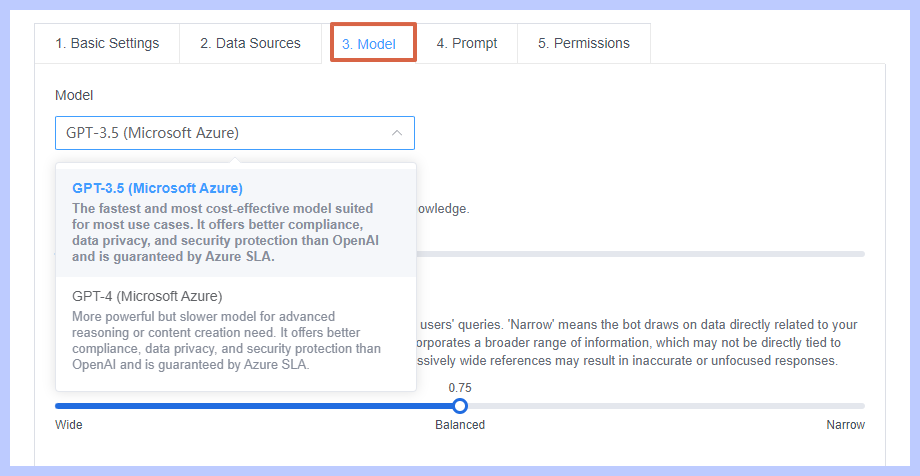● Custom Business Copilot AI Chatbot;
● Available 24/7 to Enhance Support Experience;
● Personalized Training with Customized Knowledge;
● Instant Answers to Your Enterprise-specific Questions;
● No Coding Required to Support Multiple Languages.
Learn More
Start for Free
How to Choose the Suitable Model?
Choosing the suitable model for your chatbot is a critical step that can significantly influence its performance and effectiveness. The suitable model can enhance your chatbot's ability to understand user queries and generate appropriate responses, leading to a better user experience. ChatInsight.AI currently offers two models, GPT-3.5 and GPT-4, both powered by Microsoft Azure. This guide will help you understand how to make the right choice for your specific needs.
1Understand the Models
Before selecting a model, it's essential to understand the strengths and weaknesses of each:
● GPT-3.5 (Microsoft Azure): This model is fast, cost-effective, and suitable for most use cases. It offers better compliance, data privacy, and security protection than OpenAI and is guaranteed by Azure SLA.
● GPT-4 (Microsoft Azure): This model is more powerful but slower, making it suitable for advanced reasoning or content creation needs. It also offers better compliance, data privacy, and security protection than OpenAI and is guaranteed by Azure SLA.

Each model has unique advantages:
(1)Advanced Comprehension and Context Understanding: Both models comprehend and generate contextually accurate text, enhancing ChatInsight's ability to process user information and provide relevant responses.
(2)High-Quality Text Generation: Both models generate contextually relevant, human-like text, resulting in natural, engaging user interactions.
(3)Adaptability and Customization: Both models are adaptable and can be fine-tuned to meet specific enterprise needs, making ChatInsight highly customizable for various business scenarios.
(4)Compliance, Data Privacy, and Security: Both models offer better compliance, data privacy, and security protection than OpenAI and are guaranteed by Azure SLA.
However, GPT-4 surpasses GPT-3.5 in several aspects:
(1)Linguistic Finesse: GPT-4 has improved understanding and generation of different dialects compared to GPT-3.5. It can also respond more sensitively to emotions expressed in the text.
(2)Information Synthesis: GPT-4 can answer complex questions by synthesizing information from multiple sources, a task GPT-3.5 may need help with.
(3)Creativity and Coherence: GPT-4 can produce more coherent and creative content than GPT-3.5.
(4)Complex Problem-Solving: GPT-4 demonstrates a stronger ability to solve complex mathematical and scientific problems than GPT-3.5.
(5)Programming Power: GPT-4 can generate code snippets or debug existing code more efficiently than GPT-3.5, which benefits software developers.
(6)Image and Graphics Understanding: Unlike GPT-3.5, which focuses primarily on text, GPT-4 can analyze and comment on images and graphics.
(7)Reduction of Inappropriate or Biased Responses: GPT-4 implements mechanisms to minimize undesirable results, making it a more reliable and ethically responsible AI than GPT-3.5.

2Factors to Consider When Choosing a Model
When selecting a model, you can consider the following factors:
Nature of Your Business: The nature of your business and the complexity of the queries your chatbot will handle are crucial factors.
If your business is more technical, you might need a model that can understand and respond to complex queries. This time, the more powerful GPT-4 model might be a better choice.
If your business involves complex reasoning or content creation, the more powerful GPT-4 model might be a better choice.
● Response Time: If response time is a crucial factor for your business, you may want to choose the GPT-3.5 model, which is faster and more cost-effective and suitable for most use cases.
● Size of Your Knowledge Base: The size of your knowledge base can also influence the choice of model. If your knowledge base is extensive, you may need a more powerful GPT-4 model to handle large amounts of information.
● Type of User Queries: The type of queries your chatbot will handle can also guide your choice of model. If your chatbot deals with more straightforward, fact-based queries, then the simpler GPT-3.5 model may be enough. However, if your chatbot needs to handle more complex, context-based queries, you may need a more advanced GPT-4 model.
● Compliance, Data Privacy, and Security: Both models offer better compliance, data privacy, and security protection than OpenAI and are guaranteed by Azure SLA.
● Multilingual Support: When selecting a chatbot model, it is crucial to consider multi-language support. Suppose your customer base is diverse, from various countries or regions, and speaks multiple languages. In that case, the chatbot's ability to comprehend and respond in the respective languages can significantly enhance the user experience. Because both GPT-3.5 and GPT-4 support multiple languages, you can choose from both models.
● Image Support: If your business needs are limited to text-based interactions, the GPT-3.5 model should be enough. However, if your business necessitates a chatbot capable of providing image-based responses, you might consider opting for the GPT-4.0 model, which boasts image analysis and response capabilities.
● Cost-effectiveness: The cost of implementing and maintaining the chatbot model should also be considered. GPT-3.5 is generally more cost-effective, making it a good choice for most use cases.

3Implementing and Testing the Chosen Model
Once you've chosen a model, implement it into your chatbot and conduct thorough testing. This will allow you to see how well the model performs in real-world scenarios and make any necessary adjustments.
In conclusion, choosing the right model for your chatbot is a crucial step in ensuring its effectiveness. By carefully considering your business needs and evaluating the available models, you can select a model that will enhance your chatbot's performance and provide a seamless user experience.
Still need help? Submit a request >>